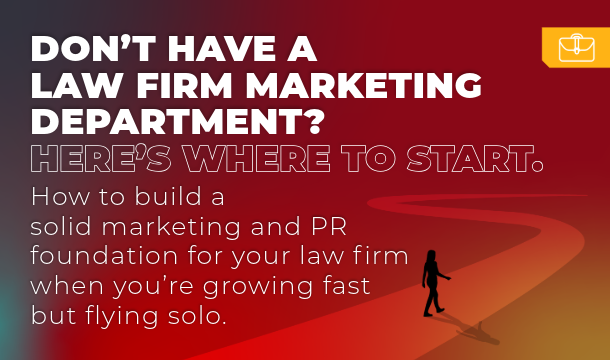Don’t have a law firm marketing department? Here’s where to start
How to build a solid marketing and PR foundation for your law firm when you’re growing fast but flying solo.
There comes a time in every growing law firm’s life when the attorney or staff member who moonlights as the “marketing person” starts to feel — how should I put this? — less sane than they used to. What was previously a random but manageable side gig has mutated into a multiheaded beast of Chambers submissions, half-finished attorney bios and sporadic social media posts.
If you’ve reached this point, I’m sorry. But also, congratulations. It means you’re growing. Every successful midsize law firm has stood exactly where you are now, at the crossroads of “we’re too big to rely on word-of-mouth” and “we’re not big enough to justify a marketing department.”
You know you need to up your game, but there’s no chief marketing officer awaiting you with a vision and a blueprint. For now, it’s just you, and that’s OK. However, the strategies that took your firm this far won’t get it where it’s going next.
This guide explains where to begin when you don’t have a marketing team but you do have ambition, an impressive roster of attorneys and just enough time to read this post before your next meeting. Let’s go.
1. Start with strategy
When your firm’s marketing has suffered from neglect, it’s tempting to just start doing something, anything, to make up for lost time. But scattershot LinkedIn posts and newsletters without marketing strategy are just that, and your target audience will sense it.
While you fight the urge to fling marketing content into the void like confetti, step back and ask the right questions:
- Who are you trying to reach? Is your ideal audience general counsel at midmarket companies, high-net-worth individuals or fast-growing startups?
- What are their biggest pain points? Are they frustrated with regulatory complexity, burned by astronomically expensive legal fees or managing high-stakes risks in rapidly changing markets?
- What do you want them to know, think or do? How does your firm’s experience, culture and approach intersect with what your ideal client cares most about?
- Why should they choose you? What sets your firm apart in a sea of sameness? (It’s not “excellence” or “results.” Dig deeper.)
Your messaging should center around the answers to these questions. And while you’re working with limited time and resources, your marketing efforts should focus on three things:
- Supporting your rainmakers.
- Demonstrating your firm’s greatest strengths.
- Building visibility in your key markets.
2. Use tools that scale with you
You don’t need fancy marketing software or a full tech stack right out of the gate. But a few smart, affordable tools can help you look polished, stay consistent and track what’s working.
Here’s where to begin:
Use a CRM to track relationships (start yesterday)
CRM stands for customer relationship management, and think of it as your firm’s memory. It should house all your prospective clients, referral sources, media contacts and event attendees — essentially, anyone you want to stay in touch with. If you ever want to send a newsletter, host a webinar or even just do client outreach, this list will have your back.
Start simple with tools like HubSpot’s free CRM or Lawmatics, which are intuitive and built for service businesses. Start now so you don’t have to untangle a decade of scattered contacts later. Relationships are currency in legal marketing, so if you’re not tracking them, you’re not nurturing them.
Consider email marketing platforms
Email is still one of the most effective ways to stay in touch with your target audience when done well. Choose a platform that integrates with your CRM and fits your needs and budget. Mailchimp is user-friendly, Constant Contact is ideal for small businesses, and ActiveCampaign offers more advanced automation for when you’re ready to scale.
Give your website some love
Your website should act as a business development tool, not an online brochure. Even small improvements like updating attorney bios, adding blog content or tightening practice group pages make a big difference.
Audit your firm’s site to ensure it’s:
- Mobile-friendly.
- Optimized for search engines (SEO).
- Clear about who you serve and how you help.
- Fast, functional and reflective of your brand.
3. Be selective with PR and marketing opportunities
You don’t need an in-house team or outside agency to start building credibility and visibility, but you do need to be selective. The goal isn’t just to get your firm’s name out there, but to align that exposure with what your ideal clients care about.
Here’s a breakdown of the key legal PR and marketing strategies, and how to know if they’re worth your time right now.
Public relations
1. Media pitches and interviews
Worth it when: You have a strong spokesperson, a unique point of view on current legal issues or experience relevant to breaking news.
Skip it if: You don’t have someone available to take interviews, or if your story isn’t timely or different.
2. Thought leadership (for example, contributed articles and op-eds)
Worth it when: Your attorneys have specialized knowledge and want to build credibility with general counsel, business decision-makers and peers.
Skip it if: You can’t commit to quality content or follow-through. Editors won’t accept poorly written or self-promotional articles, and your target audience won’t find value in them.
3. Press releases
Worth it when: You’re hiring new attorneys, launching a new practice area, winning a major case or opening a new office — anything truly newsworthy.
Skip it if: You’re sending them frequently for routine updates. Without a media strategy, they won’t get traction.
4. Rankings and award submissions (for example, Chambers and Partners, Benchmark Litigation and Lawdragon)
Worth it when: You’ve established a track record and can allocate time to crafting good submissions — ideally, with help from someone experienced.
Skip it if: You’re early in your growth or don’t have enough support to meet submission requirements without burning out your team.
Content marketing
1. Email newsletters
Worth it when: You have a growing client list or referral base and can offer useful insights or updates. Email is ideal for transactional, regulatory and employment practices, for which ongoing client relationships are crucial.
Skip it if: You’re sending emails with no clear value or too frequently — it can backfire and damage your reputation. This is a less effective strategy for litigation-only firms.
2. Attorney bios
Worth it when: They’re up-to-date and tailored to your audience. Bios are often your most-visited pages.
Skip it if: Never. These are table stakes, so ensure they’re current and reflect each attorney’s focus clearly.
3. Client alerts and industry updates
Worth it when: You can explain complex developments in plain English, fast. This approach is great for regulatory or litigation-heavy practices.
Skip it if: You’re late to publish or copying others. Original, timely insights or nothing.
Branding and strategy
1. Website overhaul or refresh
Worth it when: Your site is outdated, difficult to navigate or doesn’t reflect your current capabilities and value proposition.
Skip it if: You’re in a growth phase and can’t yet afford a thoughtful redesign — but do fix broken links and outdated pages.
2. Visual identity upgrade
Worth it when: Your firm’s image doesn’t match the caliber of your services and audience, or you’re repositioning your brand (for example, to expand into new markets).
Skip it if: Your logo is fine and resources are tight. Your firm’s design choices matter more than you might think, but they don’t need to be perfect for you to start marketing effectively.
3. Messaging and positioning strategy
Worth it when: You’re struggling to differentiate from competitors or don’t have a clear elevator pitch for your firm.
Skip it if: You have clarity internally and your marketing challenge is execution, not messaging.
Social media and online presence
1. LinkedIn strategy
Worth it when: Your audience is active there, and you can commit to a consistent posting schedule.
Skip it if: You’re only going to repost articles or make generic “the firm is pleased to announce” statements. No one remembers that kind of content.
2. Firm announcements and milestones
Worth it when: You have meaningful updates to share about hires, wins or community impact, and a network that would care about them.
Skip it if: You’re posting just to post. Save your energy for content that builds credibility and connection.
Events and speaking engagements
1. Speaking at industry conferences
Worth it when: You have niche skills and experience, want greater visibility among clients and referral sources, and are capable of turning speaking engagements into long-term relationships.
Skip it if: The audience isn’t right or the opportunity is more about feeding ego than strategy. Speaking engagements — especially those involving travel — can be a huge timesuck, so prioritize events with potential return on investment.
2. Hosting webinars or CLEs
Worth it when: You can offer real value and follow up with attendees afterwards.
Skip it if: You don’t have time to prep or promote the event. The payoff isn’t worth it without execution on both ends.
4. Create a culture that supports marketing
Your marketing and PR efforts will only go so far without buy-in from the rest of the firm. Leadership sets the strategy, but culture is what sustains its momentum.
If this is your firm’s first real foray into marketing and PR, it’s normal for some attorneys to be skeptical. They may view marketing as braggadocious, a distraction from client work or simply not their job. That mindset won’t change overnight, but it can shift with the right cues from leadership and the systems to make participation easy.
If partners visibly support marketing and recognize participation as a core part of business development, others will follow. You don’t need to force every attorney into the spotlight, but you do need to set clear expectations and model the behavior you want others to adopt.
Clients want to know the people behind the firm. They expect authenticity, relevance and proactive communication, especially in fast-moving, high-risk matters. Creating a culture that embraces visibility helps you attract and retain both clients and talent.
5. Consider outside help — strategically
When you hit a wall (and you will at some point), it’s OK to ask for help, but be strategic about it. Hire a freelancer or agency for specific needs, and select partners who understand the legal industry and can act as an extension of your (currently nonexistent) marketing department.
If the idea of finding and managing vendors makes your head spin, consider hiring a fractional CMO or marketing consultant to help set the vision and manage execution.
You already have a secret weapon
I hope I haven’t overwhelmed you with options, but if I have, remember: the most important weapon in your arsenal is right in front of you.
Your firm’s attorneys are content machines. Every matter they touch contains a story or insight worth sharing if captured at the right time. Your clients are also your best ambassadors, and usually happy to vouch for you in testimonials, referrals or case studies if you make the process easy and professional.
This awkward middle ground of your firm’s growth can feel like a sort of adolescence. It’s uncomfortable and confusing at times, but full of potential. Now’s the time to build habits that will scale your firm. And who knows, maybe one day you could start wearing just ONE hat. Imagine.








